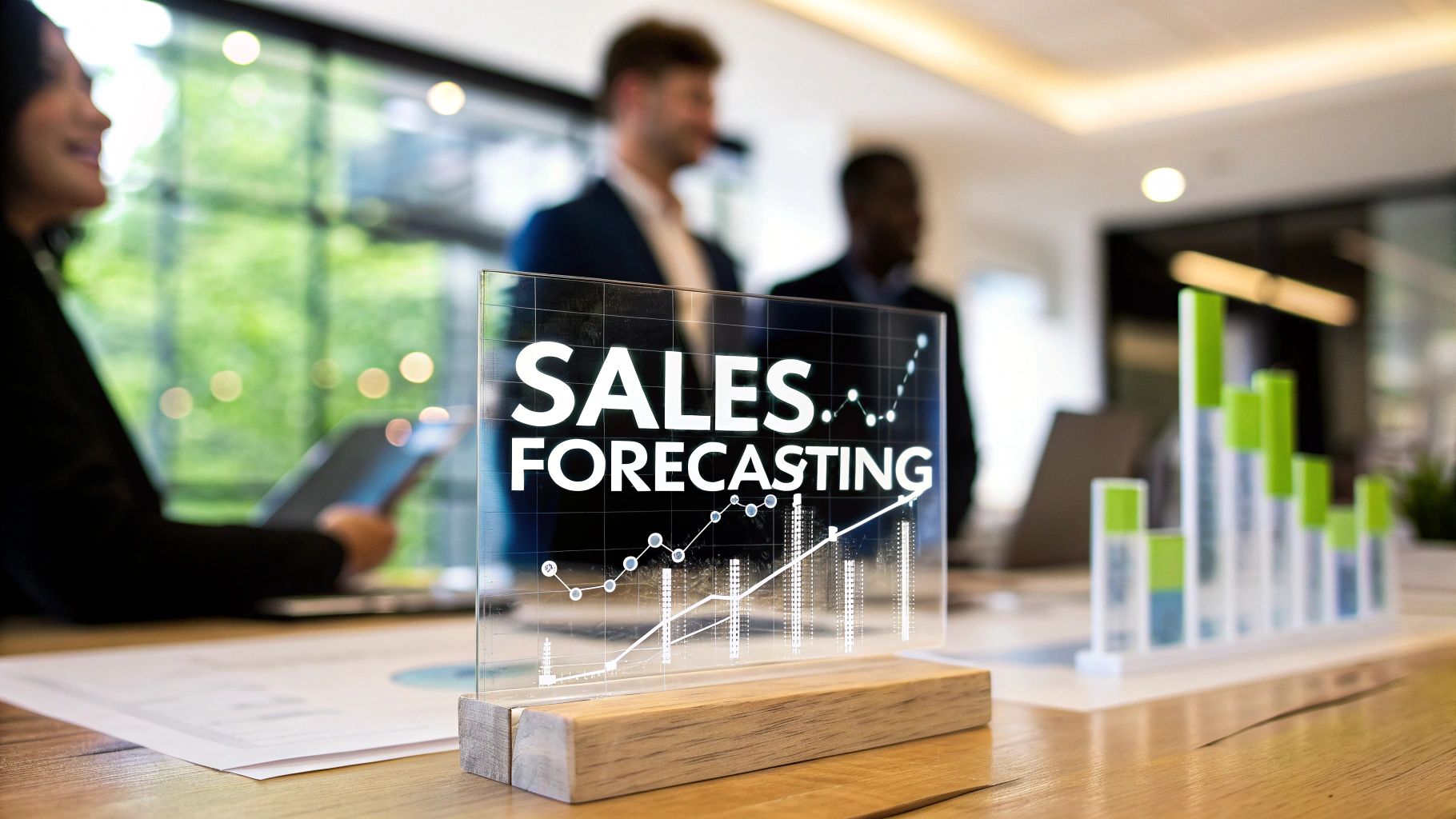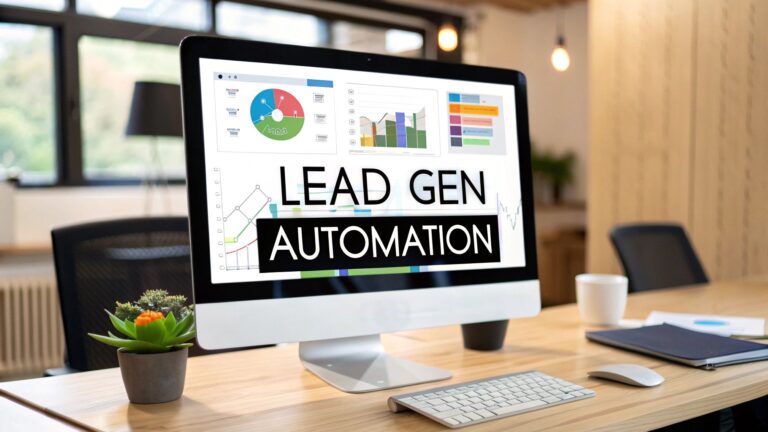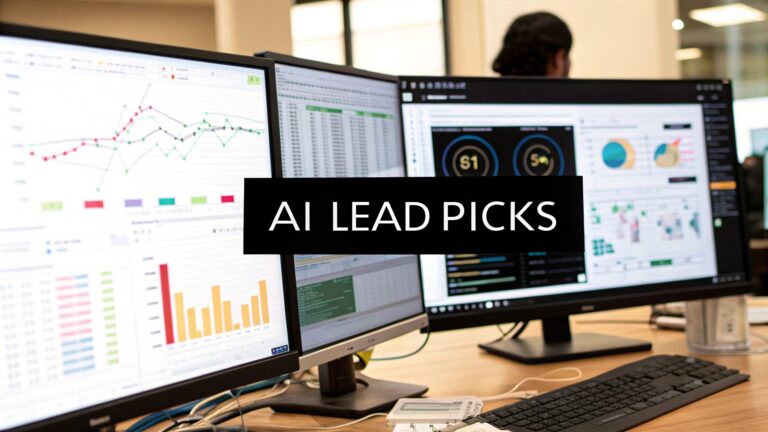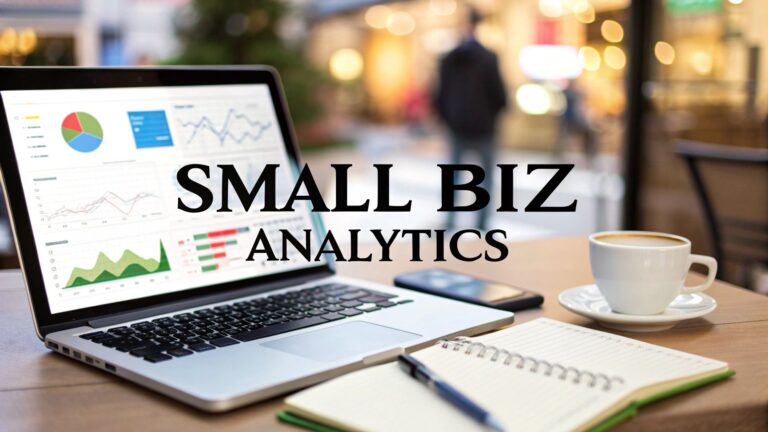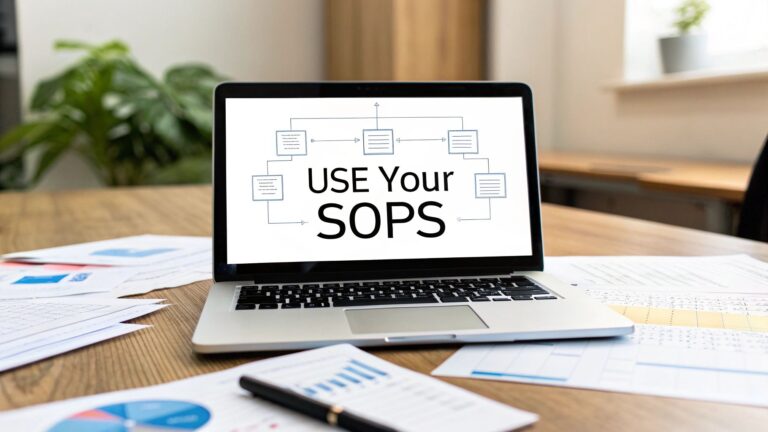What Is Sales Forecasting and How Does It Work
Think of sales forecasting as a reliable weather report for your business. It’s not about predicting the future with a crystal ball, but about using data to make highly educated guesses about upcoming revenue. In short, sales forecasting is the process of estimating what your future sales will be.
Why Sales Forecasting Is So Much More Than a Sales Number
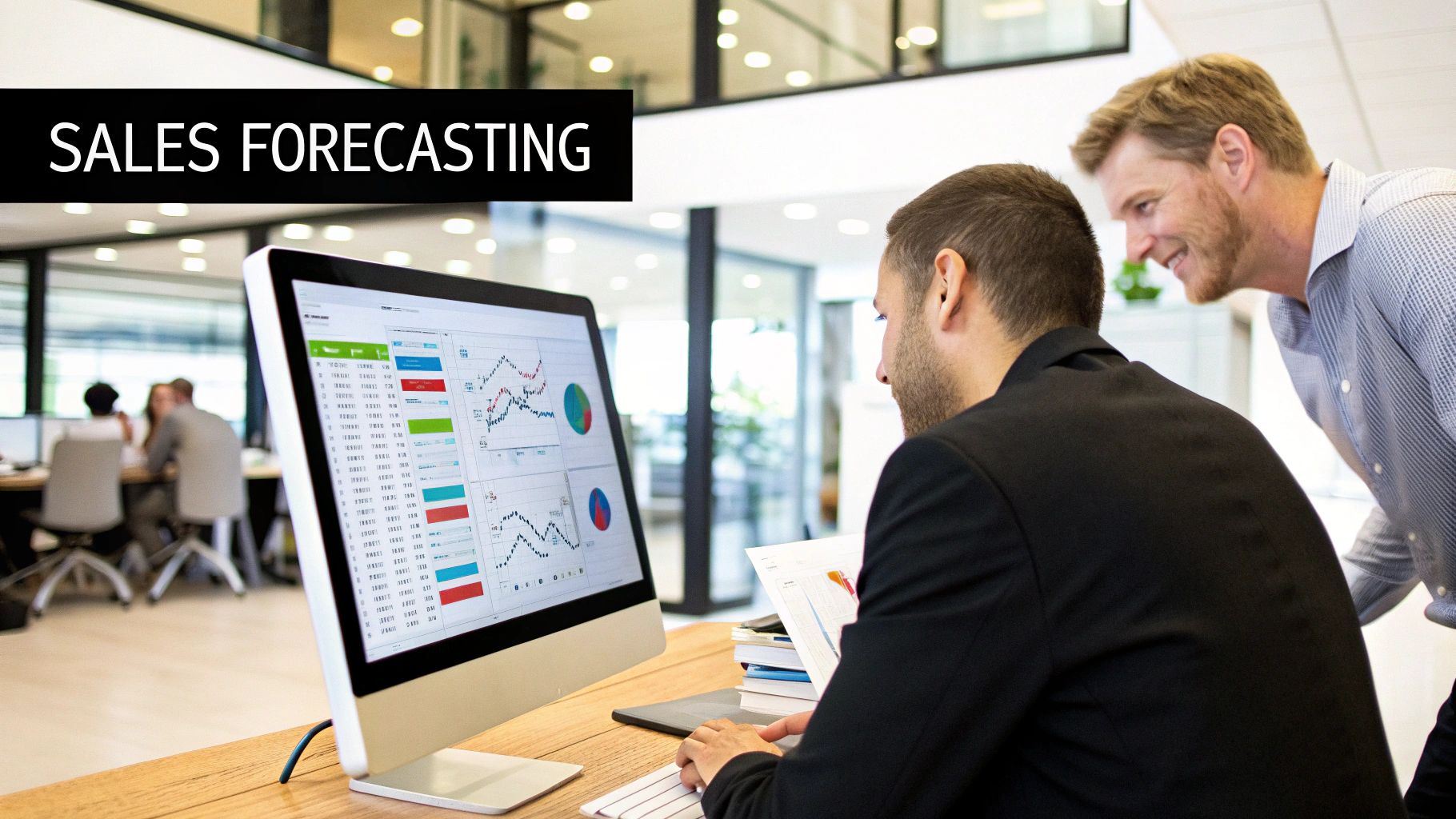
At its heart, a sales forecast is the foundational pillar for smart business planning. It’s far from being just a numbers game for the sales team; a solid forecast acts as the operational heartbeat for the entire company. It’s what turns reactive scrambling into proactive, strategic planning that actually drives sustainable growth.
This single estimate influences critical decisions across every department. Without it, you’re flying blind.
How Sales Forecasting Impacts Your Entire Business
A well-crafted forecast is the glue that holds a company’s strategy together, ensuring every department is rowing in the same direction. It provides a shared source of truth that informs everything from hiring plans to marketing budgets.
Here's a quick look at how different teams rely on it:
| Department | Primary Benefit of Accurate Forecasting |
|---|---|
| Finance & Leadership | Manages cash flow, sets realistic budgets, and secures funding based on credible revenue projections. |
| Marketing | Aligns campaign spending and lead generation goals with expected sales volume. |
| Human Resources | Determines hiring needs for sales, support, and other roles to support projected growth. |
| Operations/Production | Manages inventory, orders raw materials, and schedules production to meet demand without waste. |
Ultimately, a reliable forecast empowers everyone to work in sync toward a common goal, making resource allocation and risk management much more straightforward.
From Educated Guess To Strategic Advantage
The push for this kind of clarity is fueling serious investment in technology. The global sales forecasting software market was valued at around USD 1.3 billion and is expected to grow at an annual rate of about 9% through 2033. This surge shows just how much businesses are banking on accurate predictions to run their operations better.
A sales forecast is more than a prediction; it's a commitment to a data-driven strategy. It aligns your entire organization, turning ambiguous goals into a clear roadmap for revenue growth and operational excellence.
When you get good at sales forecasting, you create a predictable revenue engine. This builds investor confidence, boosts team morale by setting achievable targets, and lays the groundwork for real, scalable success. To see how forecasting fits into a bigger picture of business expansion, you can explore a range of growth-focused solutions.
Decoding Common Sales Forecasting Methods
Choosing the right sales forecasting method is a lot like picking the right tool for a job. You wouldn't use a hammer when you need a screwdriver, right? Each technique gives you a different angle on your future revenue, and the best fit really depends on your business, how much data you have, and what your sales process looks like.
Let's break down some of the most common approaches, starting with the more straightforward ones and working our way up to the more complex, data-heavy models. This will give you a clearer picture of what sales forecasting looks like in the real world.
Opportunity Stage Forecasting
Think of this method like tracking a package. A package that’s "out for delivery" is almost certainly arriving today, while one that's still "processing" is a bit more of a question mark. Opportunity stage forecasting applies that same logic to your sales pipeline.
Basically, you assign a probability of closing to each stage of your sales cycle based on past performance. For instance, a deal in the "Proposal Sent" stage might have a 60% chance of closing, but one that has moved to "Final Negotiation" could have an 80% chance. To get your forecast, you just multiply each deal's value by its probability and add it all up.
This approach is incredibly effective, especially for businesses that have a well-defined sales process and solid data in their CRM.
Length of Sales Cycle Forecasting
This technique is a bit like estimating your arrival time on your daily commute. If you know the drive usually takes you 30 minutes, you can be pretty confident about when you'll get to the office. This forecasting method works the same way, using the average time it takes for a deal to close to predict when your current opportunities will become actual revenue.
By digging into your historical data, you can figure out how long a typical deal hangs out in your pipeline. If your average sales cycle is 90 days, for example, you can reasonably predict that a new opportunity today will likely close in about three months. This is a go-to method for B2B companies with longer, more predictable sales cycles.
This infographic shows just how directly sales forecasting impacts major business outcomes, from revenue growth to better overall planning.
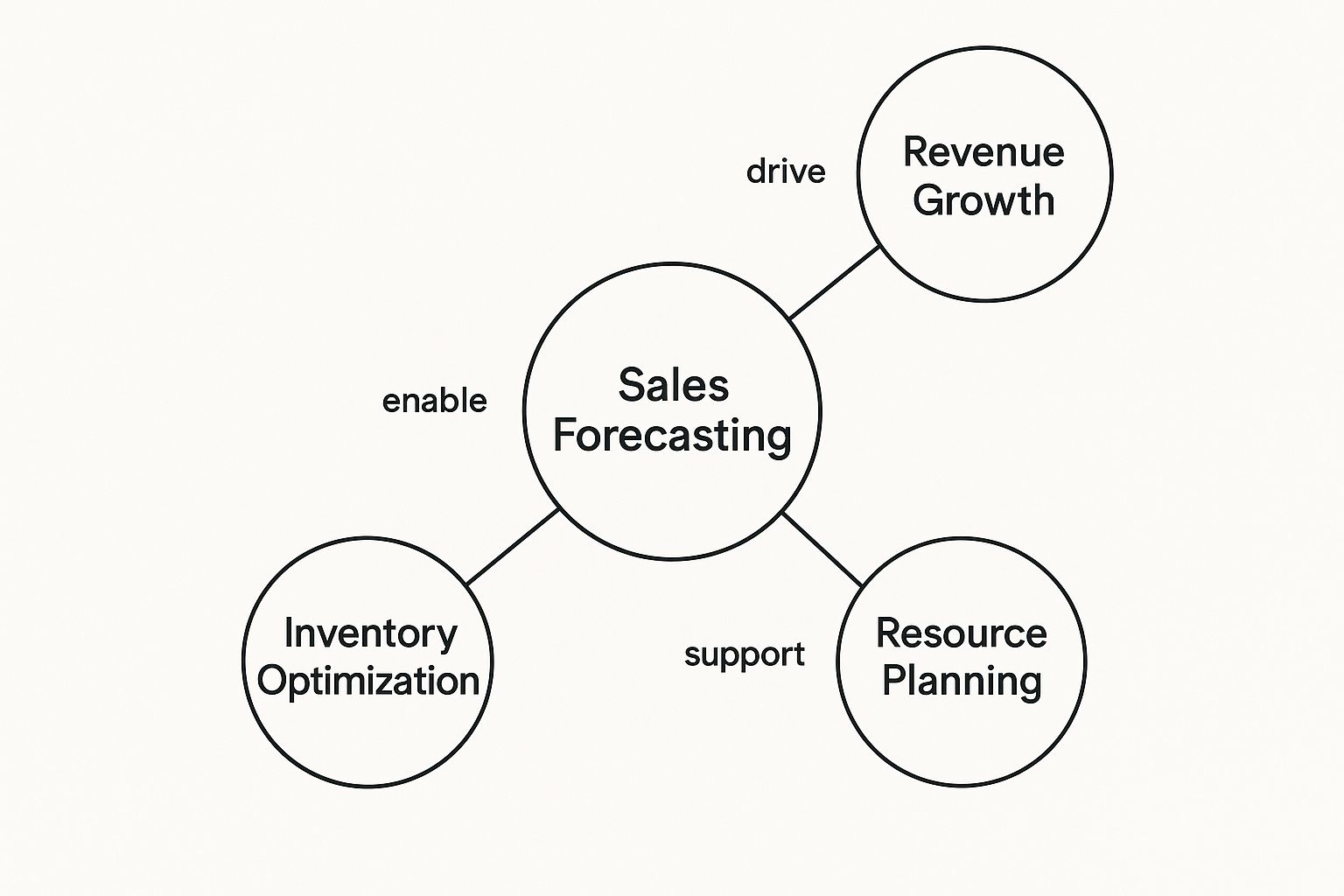
As you can see, forecasting isn't just some abstract sales metric. It's a strategic tool that fuels the entire business.
Historical Forecasting
Historical forecasting is the sales equivalent of a farmer using last year's harvest to predict this year's yield. It's one of the simplest methods out there because it works on a simple assumption: future sales will probably follow past trends. If your sales jumped by 10% in this quarter last year, you might forecast a similar 10% bump this year.
This method is beautifully straightforward and works well for stable businesses with a few years of consistent sales data under their belt. The catch? It can be unreliable in volatile markets or for companies in a rapid growth phase, as it completely ignores real-time changes.
Multivariable Analysis
Now we're getting into more advanced territory. Multivariable analysis is like a comprehensive health check-up for your sales process. Instead of just looking at one thing (like past sales), it examines multiple factors at the same time to figure out what's really driving revenue. We're talking about things like individual rep performance, the impact of a marketing campaign, lead source quality, and even broader economic trends.
This data-intensive method uses statistical models to spot the connections between all these different variables and your final sales numbers. It’s a lot more work, but the result is a much deeper, more accurate forecast that gives you the complete picture of what's influencing your success.
The Game-Changing Role of AI in Forecasting
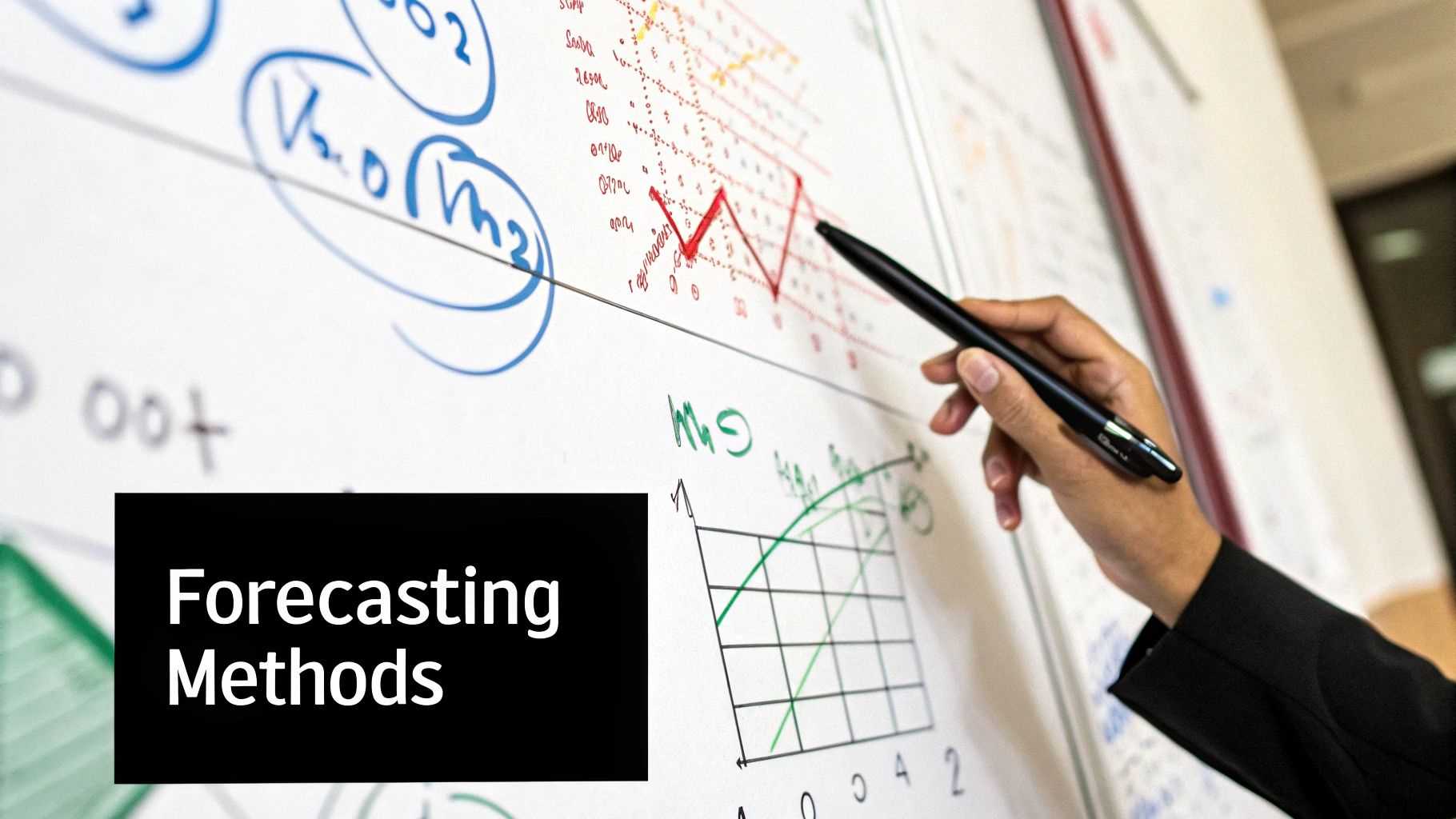
While the forecasting methods we've covered provide a solid foundation, the arrival of Artificial Intelligence (AI) represents the single biggest leap forward this field has ever seen. Think of it this way: if traditional methods are like using a reliable calculator, AI is like having a supercomputer that doesn't just crunch the numbers but actively learns and adapts as new information floods in.
This isn’t just a small step up; it's a completely different ballgame for predicting revenue. AI-powered platforms dig into far more than just your past sales figures. They can sift through thousands of data points at once—everything from the sentiment in customer emails and broad market trends to competitor pricing shifts and social media chatter. This multi-layered analysis produces predictions that are not only dynamic but uncannily accurate.
Beyond Prediction to Proactive Strategy
Here’s where AI really shines: it turns all that data into concrete, actionable intelligence for your sales team. It doesn't just hand you a number; it gives you a roadmap for how to actually hit that number.
This is what allows a business to shift from a reactive stance to a truly proactive sales strategy. The impact is huge. In fact, studies show that around 75% of companies that bring AI into their sales forecasting report not just better accuracy but also a noticeable boost in revenue growth.
So, how do AI tools pull this off?
- Pinpointing Deal Health: They can analyze communication patterns and engagement levels to flag deals that are starting to go cold long before a human would notice.
- Recommending Next Steps: The system can suggest the most effective next move for a sales rep, whether that’s sending a specific follow-up email or scheduling a quick call.
- Automating Real-time Adjustments: Your entire forecast can be updated instantly as new data comes in, making sure it always reflects the current reality, not last quarter's news.
The Power of Intelligent Automation
This kind of smart automation turns sales forecasting from a static, quarterly report into a living, breathing part of your day-to-day operations. This is all made possible by the advanced algorithms at the heart of predictive analytics. If you want to get into the nuts and bolts, you can learn more about what predictive analytics is and how it functions.
With AI, sales forecasting becomes an intelligent system that not only predicts outcomes but actively helps create them. It equips sales teams with the insights needed to focus their efforts where they will have the most impact, maximizing efficiency and revenue.
Of course, to push these capabilities to their limit, the data infrastructure underneath it all has to be top-notch. For anyone interested in the more technical side of things, a great next step is exploring how real-time data streaming can unlock low-latency analytics and GenAI for forecasting. By getting the data flow right, your sales operation can evolve into a truly intelligent engine for growth.
Choosing the Right Forecasting Tools and Software
Think of picking a forecasting tool like a pilot choosing their instruments. A simple compass might work for a short hop, but for a long-haul flight, you need a full-blown navigation system. The tool you choose will absolutely shape how you see your sales data and, ultimately, where you steer the company. Your options run the gamut from basic spreadsheets to incredibly smart, automated CRM platforms.
Your decision really comes down to what your business needs right now. A brand-new startup can get by just fine with a well-structured spreadsheet. They’re cheap and flexible. But as you grow, that manual data entry becomes a real drag—it’s slow, full of mistakes, and never up-to-date. That’s the exact moment when a dedicated tool stops being a "nice-to-have" and becomes a necessity for an accurate sales forecast.
Comparing Popular Sales Forecasting Tool Types
For most businesses on the upswing, the choice boils down to a CRM with built-in forecasting or a specialized platform that bolts on top of it.
Customer Relationship Management (CRM) systems like Salesforce, HubSpot, or Zoho CRM are usually the first big upgrade. They become your central hub for all customer information, logging every call, email, and meeting. Naturally, they come with forecasting features that pull directly from your sales pipeline data.
This is what a typical dashboard looks like in Zoho CRM, giving you a visual pulse on your sales health.
A modern CRM dashboard like this one gives you that crucial, at-a-glance overview of your open deals, incoming revenue, and where your best leads are coming from. This is the raw data that fuels any good forecast.
A great forecasting tool does more than just spit out numbers. It tells you the story of your sales process. It points out where deals get stuck, which reps are killing it, and which marketing channels are actually worth the money.
If you want to see how powerful this kind of data visualization can be, check out these excellent business intelligence dashboard examples for inspiration. They show how you can turn a mountain of numbers into clear, strategic actions. This is what a good tool should do: cut through the noise and deliver clarity.
Making the Right Choice for Your Business
Dedicated AI forecasting platforms are the next level. Tools like these often plug into your existing CRM but use sophisticated algorithms to sift through your historical data. They spot patterns you’d never see on your own and produce predictions with a much higher degree of accuracy. These are perfect for more established companies where every percentage point of accuracy can mean millions in optimized spending and resource planning.
So, how do you decide? Let’s break down the main options in a simple way.
Comparing Popular Sales Forecasting Tool Types
| Tool Type | Best For | Pros | Cons |
|---|---|---|---|
| Spreadsheets | Startups and solo operators with a handful of clients. | Extremely low-cost and you can customize them endlessly for simple needs. | Riddled with potential for human error, doesn't scale, and is always out of date. |
| CRM Systems | Growing B2B and SaaS companies that need one reliable source of truth. | Centralizes all customer data, automates sales tracking, and has built-in reporting. | Can get expensive, and their native forecasting features might be too basic for complex needs. |
| AI Platforms | Large enterprises and data-obsessed teams who demand maximum accuracy. | Incredibly accurate predictions, uncovers hidden trends, and automates insights. | The most expensive option and needs a lot of clean historical data to work its magic. |
At the end of the day, the best tool is the one your team will actually open and use every single day. Look at your budget, the size of your sales team, and how complicated your sales process is. Whether you start with a straightforward CRM or invest in a specialized platform, the mission is always the same: to get a clearer, data-driven picture of where your revenue is headed.
Building a Reliable Sales Forecasting Process
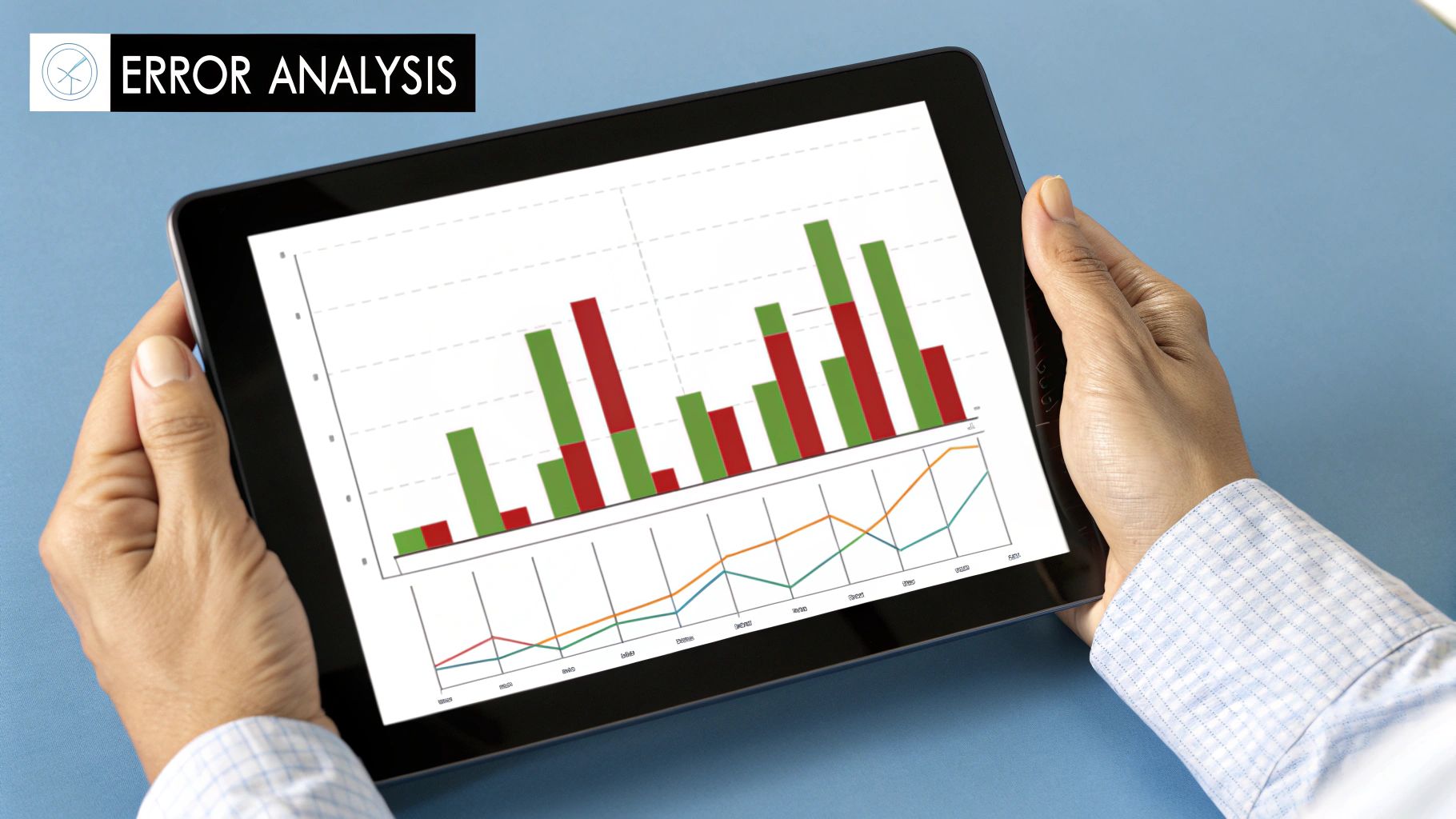
Knowing the different forecasting methods and tools is one thing. Actually building a process that delivers accurate numbers you can count on? That’s where the real work begins.
An effective sales forecasting process isn't something you set up once and forget. It’s a living, breathing system that needs structure, discipline, and a willingness to constantly refine it. It might sound intimidating, but it really just boils down to a few core principles that have stood the test of time. Follow them, and you can move from educated guesses to a forecast you’d bet your bonus on.
Start with High-Quality Data
You've heard it a million times: "garbage in, garbage out." Well, in sales forecasting, it’s the absolute truth. Your forecast is only ever as good as the data that fuels it. So, your very first step has to be making sure your Customer Relationship Management (CRM) system is clean and up-to-date.
Every deal stage, potential value, and expected close date needs to mirror what’s actually happening. Inaccurate or incomplete data is the number one reason forecasts fall apart, which makes this the foundation of your entire process. Using good sales pipeline management software can help instill the discipline needed to keep that data pristine.
Involve Your Sales Team
Your reps on the front lines are your best source of intelligence. They hear the hesitation in a customer's voice and know the real story behind a delayed signature—details that raw numbers in a CRM will never show you.
A forecast built in a leadership vacuum is just a guess. A forecast built with input from the sales team is grounded in the reality of the pipeline, blending quantitative data with essential qualitative insights.
Don't make the mistake of leaving them out of the process. Hold regular pipeline review meetings where reps can give the color and context behind their deals. This collaboration doesn't just make your forecast more accurate; it also gets the whole team invested and accountable for the numbers.
Choose the Right Model and Rhythm
There's no one-size-fits-all forecasting model. The best approach for you depends entirely on your business—how long your sales cycle is, what your business model looks like, and how much data you have to work with.
Here’s how to get started on the right foot:
- Select Your Method: If you're just starting out but have a clear sales process, a simple model like Opportunity Stage forecasting is a great place to begin. As you build up more historical data, you can start playing with more sophisticated methods.
- Establish a Cadence: Pick a schedule for reviewing and updating your forecast and stick to it. If you have a short sales cycle, you might need to do this weekly. For others, a monthly or quarterly rhythm works just fine. The key is consistency.
- Review and Adjust: A forecast is never set in stone. You have to regularly compare what you predicted with what actually happened. This is how you spot your blind spots and learn to get better. This feedback loop is the secret to sharpening your accuracy over time.
How Sales Forecasting Works in the Real World
https://www.youtube.com/embed/zdj3HDGJfhU
It's one thing to talk about forecasting models, but it’s another to see them in action. These aren’t just abstract theories; they're the practical tools businesses use every day to make critical decisions, from how much inventory to order to when they should hire their next salesperson.
So, let's look at how a few different companies put forecasting to work to solve some very real, high-stakes challenges. Each example shows how a solid forecast can give a business a serious competitive edge.
Retail and Seasonal Demand
Picture a major retailer getting ready for the holiday rush. If they get their forecast wrong, they could be facing two disasters: empty shelves with frustrated customers walking out, or a warehouse packed with unsold merchandise come January. It's a classic high-wire act.
To get it right, they lean heavily on historical forecasting. They'll dig into sales data from the last five holiday seasons to spot predictable patterns and demand spikes for certain products. But they don't stop there. They layer that historical data with current market trends to fine-tune their predictions. This helps them nail down inventory levels, schedule the right number of staff, and time their marketing campaigns perfectly.
This is also why you see major industry groups, like the National Retail Federation, publishing their own broad forecasts. They predict that overall retail sales will climb between 2.5% and 3.5% this year, giving individual retailers a valuable benchmark to measure their own projections against. You can dive deeper into these retail projections and their economic context on their site.
A real-world forecast is a story told with data. It translates past performance and current signals into a clear, actionable plan for what’s likely to happen next, removing guesswork from critical business operations.
B2B SaaS and Resource Allocation
Now, let's switch gears to a B2B SaaS company selling complex software to large enterprises. Their sales cycles are a marathon, not a sprint, often stretching out over six to nine months. For them, opportunity stage forecasting is everything.
They break their sales process down into clear stages—from the first discovery call to the final contract negotiation—and assign a probability of closing to each deal based on its stage. This isn't just a number on a spreadsheet; it's a powerful management tool. It lets sales leaders:
- Put their best people on the best deals: Senior sales engineers can be assigned to the opportunities with the highest chance of closing, instead of spreading themselves too thin.
- Give the board accurate revenue projections: They can walk into a meeting and confidently report what the next quarter’s revenue will look like.
- Spot problems before they derail the pipeline: If deals keep stalling at a certain stage, they know exactly where to step in with more training or support.
This targeted approach means the sales team is always focusing its energy where it will have the biggest impact, which is the key to building a predictable and scalable revenue stream.
Got Questions About Sales Forecasting? We've Got Answers.
As you start putting sales forecasting into practice, you're bound to run into a few questions. It’s completely normal. Let's tackle some of the most common ones to clear up any confusion and get you started on the right foot.
How Often Should We Update Our Sales Forecast?
There's no single magic number here—it really depends on the rhythm of your business. If you're in a fast-moving space like e-commerce, you might find yourself tweaking your forecast weekly. On the other hand, a B2B company with a six-month sales cycle will likely find a monthly or quarterly update is plenty.
The key isn't frequency, but consistency. The real rule of thumb is to always revisit your forecast whenever something big happens—think a major marketing launch, a competitor making a splash, or any sudden shift in the market.
What’s the Difference Between a Sales Forecast and a Sales Goal?
This one trips a lot of people up, but the distinction is crucial. It boils down to this: a forecast is a prediction, while a goal is an ambition.
-
A Sales Forecast is your best educated guess. It’s what you realistically expect to sell based on your pipeline, past performance, and what's happening in the market. Think of it as answering the question: “Where are we headed?”
-
A Sales Goal is the target you set to push your team and drive growth. It’s what you want to achieve. It answers the question: “Where do we want to go?”
Good goals are informed by a realistic forecast, but they serve very different purposes. One keeps you grounded, the other keeps you reaching.
A forecast is about prediction; a goal is about ambition. While related, they should never be confused. Your forecast tells you where you're headed, and your goal tells you where you want to go.
How Can I Make My Forecasts More Accurate?
Getting better at forecasting is a marathon, not a sprint. It's all about building good habits over time.
First and foremost, you absolutely must have clean, up-to-date data in your CRM. This is the foundation for everything else.
Next, get your sales reps involved. They're on the front lines and have insights you simply can't get from a spreadsheet. It's also a smart move to use a couple of different forecasting methods and see how they stack up against each other for a more well-rounded view.
Finally, make a habit of looking back. Regularly compare your old forecasts to what actually happened. Figure out where you went wrong, learn from it, and continuously refine your process.
Ready to build a more predictable revenue engine? MakeAutomation specializes in implementing the AI and automation frameworks that power accurate forecasting and scalable growth. Book a discovery call today.

